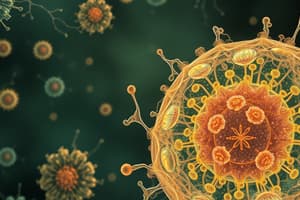Podcast
Questions and Answers
Which of the following statements accurately reflects a tenet of cell theory?
Which of the following statements accurately reflects a tenet of cell theory?
- Cells are the basic units of structure and function in all living things. (correct)
- All cells arise from spontaneous generation.
- Cells cannot arise from pre-existing cells.
- All living organisms are composed entirely of multiple types of cells.
What distinguishes prokaryotic cells from eukaryotic cells in terms of structure?
What distinguishes prokaryotic cells from eukaryotic cells in terms of structure?
- Eukaryotic cells are smaller and simpler than prokaryotic cells.
- Eukaryotic cells lack a cell wall.
- Prokaryotic cells do not have a true nucleus. (correct)
- Prokaryotic cells contain membrane-bound organelles.
Which organelle is primarily responsible for the synthesis of proteins?
Which organelle is primarily responsible for the synthesis of proteins?
- Golgi apparatus
- Ribosomes (correct)
- Vesicles
- Endoplasmic reticulum
What is the primary function of the plasma membrane in a cell?
What is the primary function of the plasma membrane in a cell?
During protein synthesis, what is the first step that takes place in the nucleus?
During protein synthesis, what is the first step that takes place in the nucleus?
What is the primary function of cilia and flagella in cells?
What is the primary function of cilia and flagella in cells?
What distinguishes gap junctions from tight junctions in animal cells?
What distinguishes gap junctions from tight junctions in animal cells?
Which of the following is a structural feature of the nuclear envelope?
Which of the following is a structural feature of the nuclear envelope?
What roles do chromosomes/chromatin serve in cells?
What roles do chromosomes/chromatin serve in cells?
What component of the cytoplasm helps in transporting substances within the cell?
What component of the cytoplasm helps in transporting substances within the cell?
How do plasmodesmata in plant cells function compared to gap junctions in animal cells?
How do plasmodesmata in plant cells function compared to gap junctions in animal cells?
What process is performed by the nucleolus within the nucleus?
What process is performed by the nucleolus within the nucleus?
What characterizes desmosomes in animal cells?
What characterizes desmosomes in animal cells?
What does the Cell Theory state about the continuity of life?
What does the Cell Theory state about the continuity of life?
Which of the following is a key characteristic that distinguishes eukaryotic cells from prokaryotic cells?
Which of the following is a key characteristic that distinguishes eukaryotic cells from prokaryotic cells?
What is the primary function of mitochondria in eukaryotic cells?
What is the primary function of mitochondria in eukaryotic cells?
Which component of the plasma membrane is primarily responsible for its fluidity?
Which component of the plasma membrane is primarily responsible for its fluidity?
What role do ribosomes play in a eukaryotic cell?
What role do ribosomes play in a eukaryotic cell?
How do prokaryotic cells differ from eukaryotic cells regarding genetic material?
How do prokaryotic cells differ from eukaryotic cells regarding genetic material?
In which of the following cellular structures would you NOT find a lysosome?
In which of the following cellular structures would you NOT find a lysosome?
Which of the following is NOT a function of the plasma membrane?
Which of the following is NOT a function of the plasma membrane?
What distinguishes chloroplasts from other organelles within plant cells?
What distinguishes chloroplasts from other organelles within plant cells?
Flashcards are hidden until you start studying
Study Notes
Cell Theory
- Cells are the fundamental units of life, responsible for structure and function.
- The activity of an organism depends on the individual and collective activities of its cells.
- The activity of the cell is governed by its subcellular structures.
- All cells originate from pre-existing cells.
Cell Types
-
Prokaryotic Cells:
- Lack a nucleus.
- DNA is located in a region called the nucleoid.
- No membrane-bound organelles.
- Examples: bacteria and archaea.
-
Eukaryotic Cells:
- DNA is enclosed within a membrane-bound nucleus.
- Contain membrane-bound organelles.
- Generally larger than prokaryotic cells.
- Examples: animal, plant, and fungal cells.
Plasma Membrane
- A phospholipid bilayer with embedded proteins, cholesterol, and glycolipids.
- Separates the intracellular (inside the cell) environment from the extracellular (outside the cell) environment.
- Regulates the passage of substances into and out of the cell.
- Plays a role in cell communication.
Cell Wall
- Found in plants and fungi.
- Provides structural support, protection, and shape to the cell.
- Composed of carbohydrate fibers embedded in a carbohydrate or protein matrix.
Cilia and Flagella
- Extensions of the plasma membrane, containing a complex of proteins that support and move the structure.
- Differences in structure lead to different movement patterns.
- Flagella: Usually one or two per cell, responsible for locomotion (moving the cell through fluid).
- Cilia: Usually numerous per cell, responsible for movement of fluid past the cell.
Cell Junctions
-
Tight junctions (animal cells):
- Form an impermeable barrier, preventing extracellular fluids from passing between cells.
-
Desmosomes (animal cells):
- Act like rivets, forming strong connections between adjacent cells.
-
Gap junctions (animal cells):
- Channels connecting the cytoplasm of adjacent cells, allowing for communication and exchange of small molecules.
-
Plasmodesmata (plant cells):
- Similar to gap junctions, connecting the cytoplasm of adjacent cells.
Nuclear Structures
-
Nuclear envelope:
- Double-layered membrane surrounding the nucleus.
-
Chromosomes/Chromatin:
- Contain genetic information (DNA) that directs protein synthesis.
-
Nucleolus:
- Contains structures for assembling rRNA and proteins into ribosomal subunits.
Cytoplasm
-
Cytosol:
- A watery solution of proteins, salts, sugars, and other solutes.
-
Cytoplasm:
- The fluid (cytosol) and all the structures within the cell, excluding the nucleus.
Transcription
- The process of copying genetic information (DNA) into RNA.
- This process takes place in the nucleus.
Studying That Suits You
Use AI to generate personalized quizzes and flashcards to suit your learning preferences.




